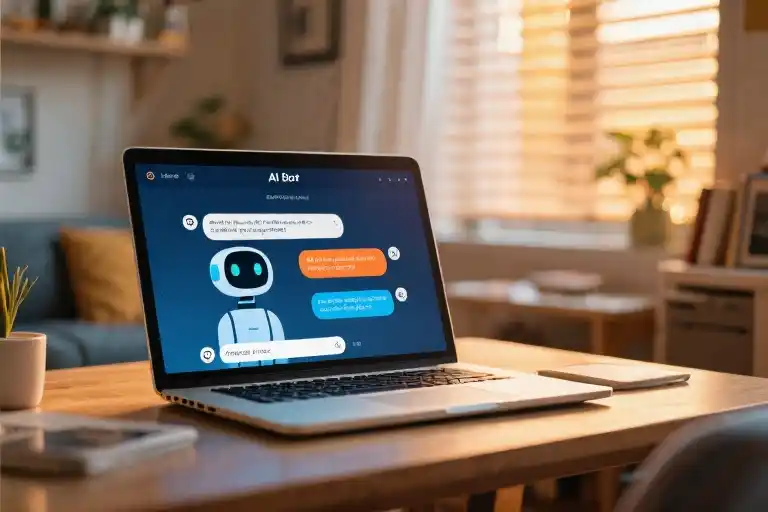The morning weather forecast predicted a 70% chance of rain, so you grabbed an umbrella on your way out. That’s how we navigate uncertainty in daily life – by understanding probabilities and preparing accordingly. Yet when it comes to AI tools like ChatGPT, many of us abandon this sensible approach, treating its responses with either blind trust or outright suspicion.
Consider the college student who recently submitted a ChatGPT-generated essay as their own work, only to discover later that several ‘historical facts’ in the paper were completely fabricated. Or the small business owner who used AI to draft legal contract clauses without realizing the model had invented non-existent regulations. These aren’t isolated incidents – they reveal a fundamental mismatch between how large language models operate and how humans instinctively interpret conversation.
At the heart of this challenge lies a peculiar paradox: The more human-like ChatGPT’s responses appear, the more dangerously we might misjudge its capabilities. That fluid conversation style triggers deeply ingrained social expectations – when someone speaks coherently about Shakespearean sonnets or explains complex scientific concepts, we naturally assume they possess corresponding factual knowledge and reasoning skills. But as AI researcher Simon Willison aptly observes, these models are essentially ‘calculators for words’ rather than general intelligences.
This introduction sets the stage for our central question: How do we productively collaborate with an artificial conversationalist that can simultaneously compose poetry like a scholar and fail at elementary arithmetic? The answer begins with recognizing three core realities about ChatGPT’s limitations:
- The fluency fallacy: Human-like eloquence doesn’t guarantee accuracy
- Metacognitive gaps: These systems lack awareness of their own knowledge boundaries
- Uneven capabilities: Performance varies dramatically across task types
Understanding these constraints isn’t about diminishing AI’s value – it’s about learning to use these powerful tools wisely. Much like checking multiple weather apps before planning an outdoor event, we need verification strategies tailored to AI’s unique strengths and weaknesses. In the following sections, we’ll map out ChatGPT’s true capabilities, equip you with reliability-checking techniques, and demonstrate how professionals across fields are harnessing its potential while avoiding pitfalls.
Remember that umbrella analogy? Here’s the crucial difference: While weather systems transparently communicate uncertainty percentages, ChatGPT will confidently present raindrops even when its internal forecast says ‘sunny.’ Our journey begins with learning to recognize when the AI is metaphorically telling us to pack an umbrella – and when it’s accidentally inventing the concept of rain.
The Cognitive Trap: When AI Mimics Humanity Too Well
We’ve all had those conversations with ChatGPT that feel eerily human. The way it constructs sentences, references cultural touchstones, and even cracks jokes creates an illusion of talking to someone remarkably knowledgeable. But here’s the unsettling truth: this very human-like quality is what makes large language models (LLMs) potentially dangerous in ways most users don’t anticipate.
The Metacognition Gap: Why AI Doesn’t Know What It Doesn’t Know
Human intelligence comes with built-in warning systems. When we’re uncertain about something, we hesitate, qualify our statements (“I think…”, “Correct me if I’m wrong…”), or outright admit ignorance. This metacognition—the ability to monitor our own knowledge—is glaringly absent in current AI systems.
LLMs operate on a fundamentally different principle: they predict the next most likely word in a sequence, not truth. The system has no internal mechanism to distinguish between:
- Verified facts
- Plausible-sounding fabrications
- Outright nonsense
This explains why ChatGPT might confidently:
- Cite non-existent academic papers
- Provide incorrect historical dates
- Invent mathematical proofs with subtle errors
The Shakespeare Paradox: When Eloquence Masks Incompetence
Consider this revealing test: Ask ChatGPT to quote Shakespeare’s sonnets (which it does beautifully), then immediately follow up with “Count the letters in the last word you just wrote.” The results are startling—the same system that flawlessly recites Elizabethan poetry often stumbles on basic counting tasks.
This paradox highlights a critical limitation:
| Human Intelligence | AI Capability |
|---|---|
| Language skills correlate with other cognitive abilities | Verbal fluency exists independently of other skills |
| Knowledge forms an interconnected web | Information exists as statistical patterns |
| Admits uncertainty naturally | Defaults to confident responses |
How Language Models Exploit Our Cognitive Biases
Several deeply ingrained human tendencies work against us when evaluating AI outputs:
- The Fluency Heuristic: We equate well-constructed language with accurate content. A Princeton study showed people rate grammatically perfect but false statements as more credible than poorly expressed truths.
- Anthropomorphism: Giving systems human-like interfaces (conversational chatbots) triggers social responses. We unconsciously apply human interaction rules, like assuming our conversation partner operates in good faith.
- Confirmation Bias: When AI generates something aligning with our existing beliefs, we’re less likely to scrutinize it. This creates dangerous echo chambers, especially for controversial topics.
Practical Implications
These cognitive traps manifest in real-world scenarios:
- Academic Research: Students may accept fabricated citations because the writing “sounds academic”
- Medical Queries: Patients might trust dangerously inaccurate health advice delivered in professional medical jargon
- Business Decisions: Executives could base strategies on plausible-but-false market analyses
Simon Willison’s “calculator for words” analogy proves particularly helpful here. Just as you wouldn’t trust a calculator that sometimes returns 2+2=5 without warning, we need similar skepticism with language models—especially when they sound most convincing.
This understanding forms the crucial first step in developing what AI researchers call “critical model literacy”—the ability to interact with LLMs productively while avoiding their pitfalls. In our next section, we’ll map out exactly where these tools shine and where they consistently fail, giving you a practical framework for deployment decisions.
Mapping AI’s Capabilities: Oases and Quicksands
Understanding where AI excels and where it stumbles is crucial for effective use. Think of ChatGPT’s abilities like a terrain map – there are fertile valleys where it thrives, and dangerous swamps where it can lead you astray. This section provides a practical guide to navigating this landscape.
The 5-Zone Competency Matrix
Let’s evaluate ChatGPT’s performance across five key areas using a 100-point scale:
- Creative Ideation (82/100)
- Strengths: Brainstorming alternatives, generating metaphors, producing draft copy
- Weaknesses: Maintaining consistent tone in long-form content, truly original concepts
- Information Synthesis (75/100)
- Strengths: Summarizing complex topics, comparing viewpoints, explaining technical concepts simply
- Weaknesses: Distinguishing authoritative sources, handling very recent developments
- Language Tasks (68/100)
- Strengths: Grammar correction, basic translations, stylistic suggestions
- Weaknesses: Nuanced cultural references, preserving voice in literary translations
- Logical Reasoning (45/100)
- Strengths: Following clear instructions, simple deductions
- Weaknesses: Multi-step proofs, spotting contradictions in arguments
- Numerical Operations (30/100)
- Strengths: Basic arithmetic, percentage calculations
- Weaknesses: Statistical modeling, complex equations without plugins
When AI Stumbles: Real-World Cautionary Tales
Legal Landmines
A New York attorney learned the hard way when submitting ChatGPT-generated legal citations containing six fabricated court cases. The AI confidently invented plausible-sounding but nonexistent precedents, demonstrating its lack of legal database awareness.
Medical Missteps
Researchers found that when asked “Can I take this medication while pregnant?” current models provided dangerously inaccurate advice 18% of the time, often missing crucial drug interactions. The fluent responses masked fundamental gaps in pharmacological knowledge.
Academic Pitfalls
A peer-reviewed study showed ChatGPT-generated literature reviews contained 72% factual accuracy – concerningly high for completely fabricated citations. The AI “hallucinated” credible-looking academic papers complete with fake DOI numbers.
Routine vs. Novel Challenges
AI handles routine tasks significantly better than novel situations:
- Established Processes:
✔️ Writing standard business emails (87% appropriateness)
✔️ Generating meeting agenda templates (92% usefulness) - Unpredictable Scenarios:
❌ Interpreting vague customer complaints (41% accuracy)
❌ Responding to unprecedented events (23% relevance)
This pattern mirrors what cognitive scientists call “system 1” (fast, pattern-matching) versus “system 2” (slow, analytical) thinking. Like humans on autopilot, AI performs best with familiar patterns but struggles when needing true reasoning.
Practical Takeaways
- Play to strengths: Delegate repetitive writing tasks, not critical analysis
- Verify novelty: Double-check any information outside standard knowledge bases
- Hybrid approach: Combine AI drafting with human expertise for best results
Remember: Even the most impressive language model today remains what researcher Simon Willison calls “a calculator for words” – incredibly useful within its designed function, but disastrous when mistaken for a universal problem-solver.
The Hallucination Survival Guide
We’ve all been there – you ask ChatGPT a straightforward question, receive a beautifully crafted response, only to later discover it confidently stated complete fiction as fact. This phenomenon, known as ‘AI hallucination,’ isn’t just annoying – it can derail projects and damage credibility if left unchecked. Let’s build your defensive toolkit with three practical verification strategies.
The Triple-Check Verification System
Think of verifying AI outputs like proofreading a colleague’s work, but with higher stakes. Here’s how to implement military-grade fact checking:
- Source Tracing: Always ask for references. When ChatGPT claims “studies show…”, counter with “Which specific studies? Provide DOI numbers or researcher names.” You’ll quickly notice patterns – credible answers cite verifiable sources, while hallucinations often use vague phrasing.
- Lateral Validation: Take key claims and:
- Search exact phrases in quotation marks
- Check against trusted databases like Google Scholar
- Look for contradictory evidence
- Stress Testing: Pose the same question differently 2-3 times. Consistent answers increase reliability, while fluctuating responses signal potential fabrication.
Red Flag Lexicon
Certain phrases should trigger immediate skepticism. Bookmark these high-risk patterns:
- Academic Weasel Words:
“Research suggests…” (which research?)
“Experts agree…” (name three)
“It’s commonly known…” (by whom?) - Numerical Deceptions:
“Approximately 78% of cases…” (rounded percentages with no source)
“A 2023 study found…” (predating the study’s actual publication) - Authority Mimicry:
“As a medical professional…” (ChatGPT has no medical license)
“Having worked in this field…” (it hasn’t)
The Confidence Interrogation
Turn the tables with these prosecutor-style prompts that force transparency:
- “On a scale of 1-10, how confident are you in this answer?”
- “What evidence would contradict this conclusion?”
- “Show me your chain of reasoning step-by-step”
Notice how responses change when challenged. Reliable information withstands scrutiny, while hallucinations crumble under pressure.
Pro Tip: Install the “GPTZero” browser extension for real-time hallucination alerts during ChatGPT sessions. It analyzes responses for typical fabrication patterns.
Real-World Verification Workflow
Let’s walk through checking a claim about “the health benefits of dark chocolate”:
- Initial AI Response:
“A 2022 Harvard study found daily dark chocolate consumption reduces heart disease risk by 32%.” - Verification Steps:
- Source Request: “Provide the Harvard study’s title and lead researcher”
ChatGPT backtracks: “I may have conflated several studies…” - Lateral Search: No Harvard study matches these exact parameters
- Stress Test: Asking again yields a 27% reduction claim from a “2019 Yale study”
- Conclusion: This is a composite hallucination mixing real research areas with fabricated specifics.
Remember: ChatGPT isn’t lying – it’s statistically generating plausible text. Your verification habits determine whether it’s a liability or asset. Tomorrow’s coffee break conversation might just be safer because of these checks.
The Professional’s AI Workbench
For Educators: Assignment Grading Prompts That Work
Grading stacks of student papers can feel like scaling Mount Everest—daunting, time-consuming, and occasionally vertigo-inducing. ChatGPT serves as your digital sherpa when used strategically. The key lies in crafting prompts that transform generic feedback into targeted learning moments.
Effective prompt structure for educators:
- Role specification: “Act as a high school English teacher with 15 years’ experience grading persuasive essays”
- Rubric anchoring: “Evaluate based on thesis clarity (20%), evidence quality (30%), logical flow (25%), and grammar (25%)”
- Tone calibration: “Provide constructive feedback using the ‘glow and grow’ framework—first highlight strengths, then suggest one specific improvement”
Sample workflow:
- First pass: “Identify the 3 strongest arguments in this student essay about climate change policies”
- Deep dive: “Analyze whether the cited statistics in paragraph 4 accurately support the claim about rising sea levels”
- Personalization: “Suggest two thought-provoking questions to help this student deepen their analysis of economic impacts”
Remember to always cross-check historical facts and calculations. A biology teacher reported ChatGPT confidently “correcting” a student’s accurate pH calculation—only to introduce an error of its own.
For Developers: Code Review Safety Nets
That comforting feeling when your linter catches a syntax error? ChatGPT can extend that safety net to higher-level logic—if you know how to ask. These techniques help avoid the “works in theory, fails in production” trap.
Code review prompt architecture:
1. Context setting: "Review this Python function designed to process CSV files with medical data"
2. Constraints: "Focus on HIPAA compliance risks, memory efficiency with 1GB+ files, and edge cases"
3. Output format: "List potential issues as: [Severity] [Description] → [Suggested Fix]"Pro tips from senior engineers:
- The sandwich test: Ask ChatGPT to “Explain what this code does as if teaching a junior developer”—if the explanation seems off, investigate further
- Historical checks: “Compare this algorithm’s time complexity with version 2.3 in our repository”
- Danger zone detection: “Flag any code patterns matching OWASP’s top 10 API security risks”
One fintech team created a pre-commit ritual: They run ChatGPT analysis alongside unit tests, but only act on warnings confirmed by both systems.
For Marketers: Creativity With Guardrails
Brainstorming ad copy at 4 PM on a Friday often produces either brilliance or nonsense—with ChatGPT, sometimes both simultaneously. These frameworks help harness the creativity while filtering out hallucinations.
Campaign development matrix:
| Phase | ChatGPT’s Strength | Required Human Oversight |
|---|---|---|
| Ideation | 90% – Explosive idea generation | Filter for brand alignment |
| Research | 40% – Surface-level trends | Verify statistics with Google Trends |
| Copywriting | 75% – Variant creation | Check for trademarked terms |
High-ROI applications:
- A/B test generator: “Create 7 subject line variations for our cybersecurity webinar targeting CTOs”
- Tone adaptation: “Rewrite this technical whitepaper excerpt for LinkedIn audiences”
- Trend triage: “Analyze these 50 trending hashtags—which 5 align with our Q3 sustainability campaign?”
A consumer goods marketer shared their win: ChatGPT proposed 200 product name ideas in minutes. The winning name came from idea #187—after their team discarded 186 unrealistic suggestions.
Cross-Professional Wisdom
- The 30% rule: Never deploy AI output without modifying at least 30%—this forces critical engagement
- Version control: Always prompt “Give me version 3 of this output with [specific improvement]”
- Error logging: Maintain a shared doc of ChatGPT’s recurring mistakes in your field
Like any powerful tool—from calculators to Photoshop—ChatGPT rewards those who understand both its capabilities and its quirks. The professionals thriving with AI aren’t those who use it most, but those who verify best.
Knowing When to Trust Your AI Assistant
At this point, we’ve explored the fascinating quirks and limitations of large language models like ChatGPT. We’ve seen how their human-like fluency can be both their greatest strength and most dangerous flaw. Now, let’s consolidate this knowledge into practical takeaways you can use immediately.
The AI Capability Radar
Visualizing an AI’s abilities helps set realistic expectations. Imagine a radar chart with these five key dimensions:
- Creative Ideation (85/100) – Excels at brainstorming, metaphor generation
- Language Tasks (80/100) – Strong in translation, summarization
- Technical Writing (65/100) – Decent for documentation with verification
- Mathematical Reasoning (30/100) – Prone to arithmetic errors
- Factual Accuracy (40/100) – Requires cross-checking sources
This visualization reveals why ChatGPT might brilliantly analyze Shakespearean sonnets yet fail at simple spreadsheet calculations. The uneven capability distribution explains those frustrating moments when AI assistants seem brilliant one moment and bafflingly incompetent the next.
Your Action Plan
Based on everything we’ve covered, here are three concrete next steps:
A. Bookmark the Reliability Checklist
- Verify unusual claims with primary sources
- Watch for “confidence words” like “definitely” or “research shows” without citations
- For numerical outputs, request step-by-step reasoning
B. Experiment with Profession-Specific Templates
Teachers: “Identify three potential weaknesses in this student essay while maintaining encouraging tone”
Developers: “Review this Python function for security vulnerabilities and explain risks in plain English”
Marketers: “Generate ten headline variations for [product] emphasizing [unique benefit]”
C. Share the “Calculator” Mindset
Forward this guide to colleagues who either:
- Fear using AI tools entirely, or
- Trust ChatGPT outputs without scrutiny
The Paradox of AI Honesty
Here’s our final insight: When your AI assistant says “I don’t know” or “I might be wrong about this,” that’s actually its most trustworthy moment. These rare admissions of limitation represent the system working as designed – acknowledging boundaries rather than fabricating plausible fictions.
Treat ChatGPT like you would a brilliant but eccentric research assistant: value its creative sparks, but always verify its footnotes. With this balanced approach, you’ll harness AI’s productivity benefits while avoiding its pitfalls – making you smarter than the machine precisely because you understand what it doesn’t.





